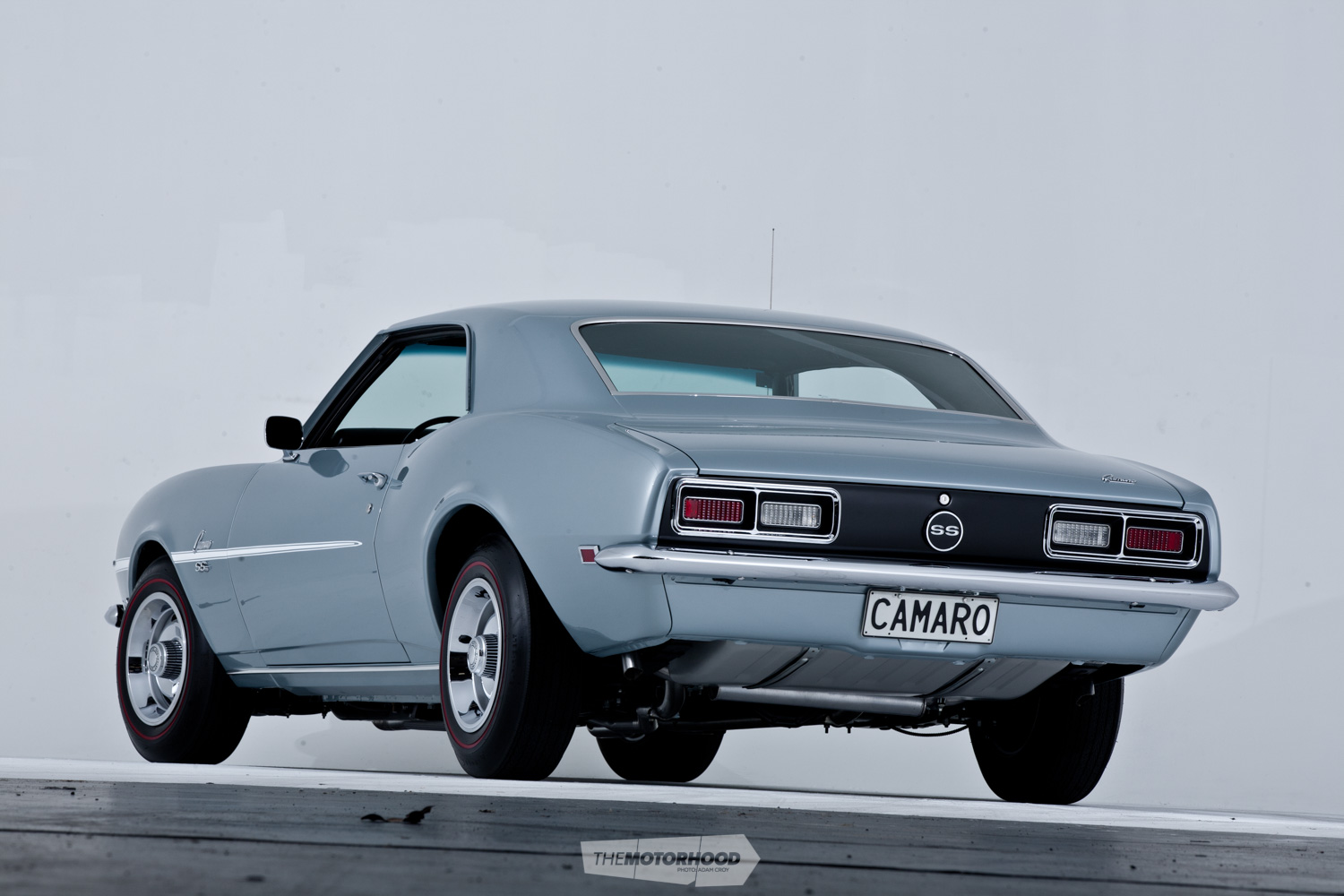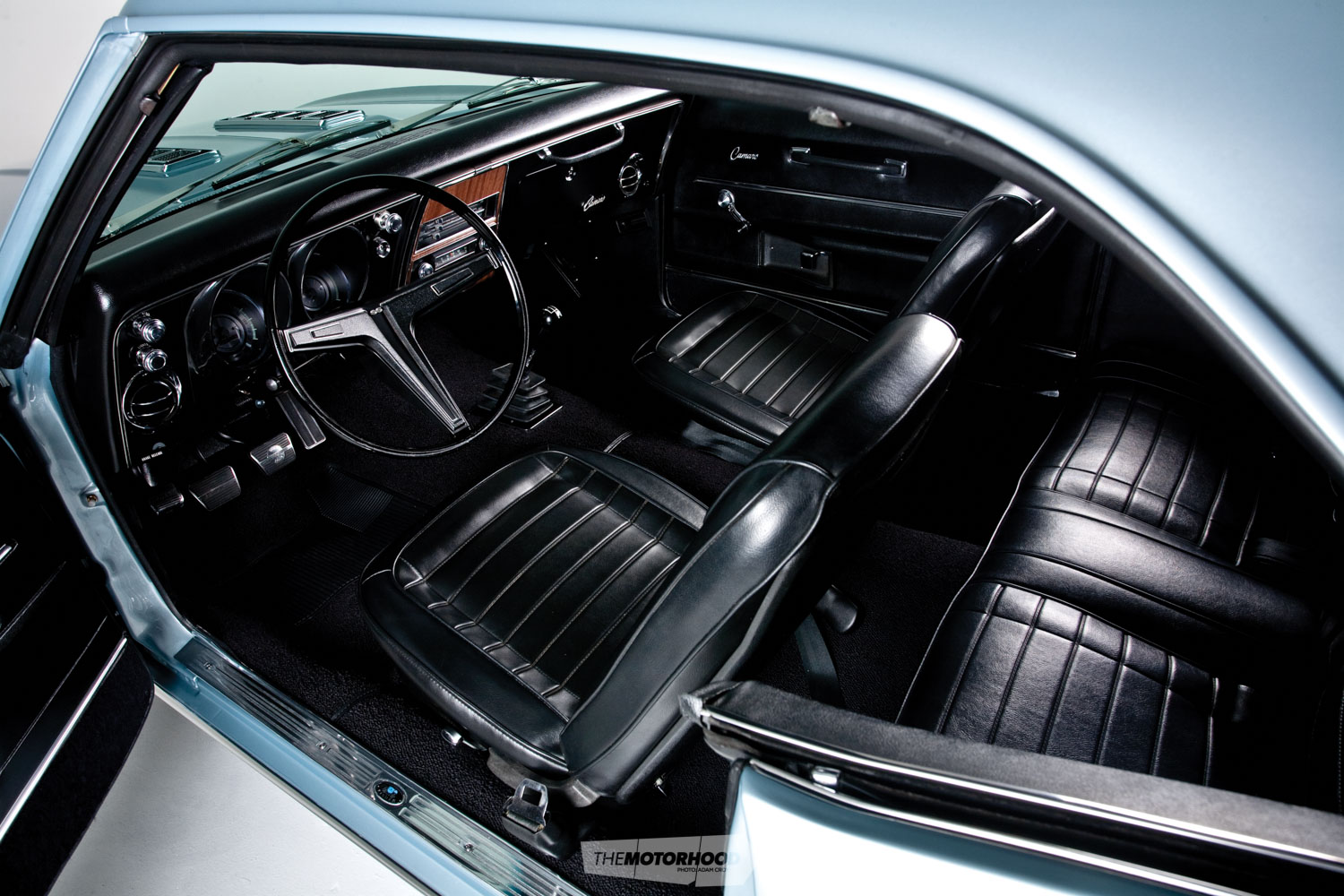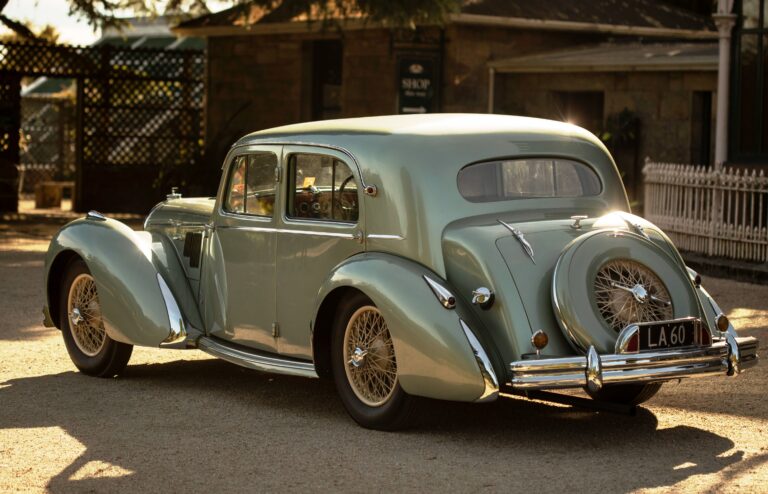This extremely rare and desirable, L89-optioned Camaro SS was one of the stars at this year’s Ellerslie Intermarque Concours

Back in 1964, when Ford introduced its new Mustang, the General Motors camp remained quiet and somewhat dubious about the introduction of a four-seater sports car. However, GM soon sat up and took notice when, only four months after the Mustang’s release, the new cars were quite literally flying out the doors of Ford showrooms across the US, with 100,000 units sold in the first six months. In 1964 the old saying, ‘selling faster than hotcakes’ soon became ‘these hotcakes are selling faster than Mustangs’.
The top brass at GM quickly came to the conclusion that a four-seater sports car was indeed what the American public was crying out for, although, ironically, Ford had actually based its Mustang on the Chevrolet Corvair Monza.
The race was now on for GM to build its own version of the Mustang, a task immediately embarked upon under the direction of Henry C Haga. The interior design aspect of the new project was handed over to George Angersbach, who had a significant influence over the design aspect of the Corvette, Corvair, and the Chevy II, which became the Nova in 1968.
New Arrival
Finally, in 1967 Chevrolet unveiled the Camaro. The folks at GM thought the name Camaro was a good one simply because it was new, and no one knew what it meant — although, according to an old French dictionary, Camaro meant friend and that was enough to satisfy them. The car was also given other interim names along the way by GM and the press — names such as Nova, Panther, Chaparral, and Wildcat (later used by Buick) — and rumours at the time suggested the suits within General Motors considered incorporating ‘GM’ into the name, coming up with all sorts of weird and wonderful names like G-Mini, which later developed into GeMini, and finally Gemini, a name many of us are now familiar with. But it wasn’t to be, and the name was soon given the elbow purely and simply because they didn’t want the letters GM used in case the Camaro turned out be an absolute failure.

The folks at GM thought the name Camaro was a good one simply because it was new, and no one knew what it meant
Meanwhile over at Ford, a little bit of research uncovered another meaning, this time from a Spanish dictionary, in which the word Camaro meant ‘a small, shrimp-like creature.’ Naturally, it couldn’t wait to reveal its latest findings to the automotive press, which had a good laugh at GM’s expense and an even bigger one when some other bright spark discovered yet another meaning: ‘loose bowels.’ However, it didn’t take long for the laughter to stop after the introduction of the striking new Camaro in 1967.
With its late arrival on the pony car scene, the Camaro rapidly made up for lost time, with Chevrolet offering a vast array of luxury and performance options available on RS, SS, and Z-28 platforms. The body styling with its long bonnet and short boot-lid design was based on a 2.74m wheelbase and could be bought in either coupé or convertible configuration. The bodies were semi-unitised, which meant the front chassis consisted of a sub-frame attached to the underbody by four rubber-isolated mounts, and the rear chassis remained an integral part of the uni-body offering occupants a smoother and quieter ride than a conventional full uni-body car. This technique had been used on several European cars, including a couple of Mercedes-Benz models, combining the best of both worlds — a larger interior and more boot space than was possible with a traditional frame.
The Camaro was also well equipped with a full range of optional engines, starting with a 3.8-litre straight-six cylinder engine as well as the more performance-oriented 5.4-litre V8. Additionally, Chevrolet created a new engine with increased displacement just for the Camaro in the form of a 5.7-litre (350ci) V8 that produced 220kW.

By 1968 Chevrolet’s true sports car, the Corvette, was stealing the limelight at Chevy dealers across the country with its newly released C3 model, so the second-year Camaro was limited to minor changes that included a mild grille redesign, divided tail lights, and side indicator lights added to the front guards and rear quarter panels. Front running lights on non-RS models were changed from circular to oval, the interior console as well as all the gauges were new, and a passenger-side grab-handle was available with either one of two custom interior groups. Side vent windows that were seen on 1967 models were gone, replaced with Chevrolet’s new fresh-air-inlet system called Astro-Ventilation.
By its second year, the Camaro was already stealing away some of the pony car market. Buyers had the option of purchasing anything from the plain Jane Sport Coupe, drag strip-ready Super Sport or the tarmac-shredding Z-28 road racing machine. The Rally Sport option with hidden headlights could be added as a separate package to any of those models, so there was quite literally something to suit everyone’s taste. The optional Rally Sport package was touted by GM as the glamour model, whilst the SS was referred to in the brochures as “a husky performer and looks it”. These bold statements were hardly surprising considering the option list of V8 power plants. In 1968 there was a third 6489cc (396ci) L35 power plant available with power halfway between the already existing 242kW (325bhp) L34 and 280kW (375bhp) L78 models.
In addition, for the ultimate performance enthusiast, there was the so-called L89 like our featured car sporting such performance equipment as aluminium heads, larger valves and a custom Holley carburettor — only 272 customers checked off this option. Not surprising since the engine option cost an additional US$868.95, which was about one-fourth the cost of the basic Camaro model, making this one super-rare and super-powerful muscle car. Upgraded suspension with multi-leaf rear springs and special equipment features also made this model stand out from the crowd.

Muscle Car Passion
Those people who know Wayne Grimmer, or know of him, could be forgiven for searching for any MOPAR emblems on this featured car. Wayne is highly regarded for his MOPAR passion and, indeed, his exciting collection of ’60s and ’70s muscle cars — but we decided to delve further and find out just how this magnificent 1968 Camaro ended up in his possession.
We’ll start by winding the clock back to 1986, a time when Wayne was ending an enjoyable five years of competitive drag racing to get married and start a family. However, he never lost his passion for American muscle cars and kept an eye out for a new, more family-friendly project. About a year later he purchased this 1968 Chevrolet Camaro after first seeing it at a friend’s house in Auckland. The Camaro was actually being stored for New Plymouth-based Kevin Smith, who’d purchased the car while residing in America and had owned it for approximately three years. During that time, Kevin had collected many parts with the intention of eventually restoring the car back to its original condition when he finally returned to NZ.
Due to the 1987 stock market crash and the downturn in the economy, Kevin decided to sell and Wayne was first to be offered the Camaro and its NOS restoration parts. So in one way he’ll always be thankful for the Wall Street crash, as it gave him the chance to acquire this car. One of the rarest Camaro models, this L89-optioned car was a ‘matching numbers’ car, and in original unrestored condition (apart from a quickie paint job).
Wayne’s first attempt at restoring the Camaro was in 1989, and he admits he was young and naive, deciding to enhance the car by choosing a colour that was not original and adding a host of optional extras like RS chrome mouldings, chrome bumper overriders and an interior console.

Wayne also attended one stint at the Father’s Day Drags in the early ’90s which netted a 13.3-second quarter-mile at 106mph (170.59kph) with a passenger on board
As an added bonus, Wayne discovered some original California registration cards dating from 1975 to 1982 buried deep inside the car’s glove box, and decided to try and contact one of the original American owners by mail to get more information about it, but was unable to make contact. It wasn’t until Wayne’s second restoration of the Camaro some 20 years later that, thanks to the power of the internet, he was finally able to locate a previous owner of the car. Through a website called Reunion.com, Wayne got in touch with the owners from the early ’70s to 1982. Wayne also learned that during the late ’70s they had repainted the car in ‘gunmetal grey’ before eventually trading it on a new 1982 Corvette.
Masters’ Class
Wayne recalls that his first restoration on this Camaro took around two years to complete, the car being ready just in time for the 1991 AMCC (American Muscle Car Club) annual car show at the old Henderson Civic Centre (later the Aquatic Centre). Wayne was delighted to receive numerous awards for his efforts — including Best Chevrolet.
Over the next 20 years, Wayne would take the Camaro out at weekends and attend the odd car run as well as entering it into other car shows. He also attended one stint at the Father’s Day Drags in the early ’90s which netted a 13.3-second quarter-mile at 106mph (170.59kph) with a passenger on board.
Other than that, this magnificent car has mainly taken pride of place in Wayne’s garage next to the other muscle cars that he’s collected over the years — these include a 1971 Plymouth Cuda 340ci (5571cc), 1973 Plymouth Cuda Pro-Street 604ci (9898cc) Hemi, 1971 Plymouth Cuda Pro-Touring 528ci (8652cc) Hemi with a six-speed Richmond manual transmission (near completion) and a 1968 Plymouth Cuda drag car, 604ci Hemi with five-speed Liberty clutchless transmission capable of a standing quarter time of 8.24 seconds at 165mph (265.5kph).
This man clearly loves power.

Buyers had the option of purchasing anything from the plain Jane Sport Coupe, drag strip-ready Super Sport or the tarmac-shredding Z-28 road racing machine
Twenty years after the first restoration, and knowing the originality and rarity of this Camaro, Wayne knew the car deserved to be restored back to the way it left the factory floor, and embarked on another total rebuild. Although it was originally intended to only take 18 months — we all know what happens when you tackle these projects — in the end, the Camaro’s second restoration took four years to complete.
Fully restored back to original condition, Wayne’s Camaro appeared at this year’s Ellerslie Intermarque Concours where it was entered into the Masters’ Class. On the day, the Chevrolet was just pipped to the post by Owen Grigg’s Chrysler 300C (as featured in last month’s edition of NZ Classic Car), with only 12 points separating the two cars.
Today, Wayne has been advised by Camaro experts in US that it’s possible his car is one of only 20 (out of the original 272 built) left in existence with the original numbers-matching factory engine and drivetrain, and they also mentioned that, for the most part, Smart-Stock and Super-Stock Class Drag Racers of the time made up the majority of ordered Camaros with the L89 aluminium-headed engine, which makes this one of the rarest Camaros ever built.

[Wayne would like to say a special thanks to his lovely and understanding wife, Sue, and two sons — Marc and Ryan. Special thanks also to Grieg McSporran from Profile Autobody Ltd for panel and paint, Paul Roper from PJR Automotive for engine blue-printing, Tom Black for upholstery, Chuck’s Restoration Supplies, DC Trading Ltd, fellow AMCC members Dave Loose, Andrew Bailey and Shane Ushaw for their help and expertise, and Clay Tocher, one of Wayne’s closest friends, for his attention to detail and dedication to this restoration project, which would not have made the 2011 Easter
American Muscle Car Show without his help.]

1968 Chevrolet Camaro SS
Engine: 396ci (6489cc) Turbo-Jet 375hp (280kW) RPO – L89 (Regular Production Order, aluminium headed engine), Heads (3919842) aluminium rectangular port, closed chamber. Due to the high cost of the L89 option (US$868.95) only 272 were fitted with this performance upgrade. According to Chevrolet this option offered a lighter engine with better weight balance and handling capabilities, four-bolt mains engine block (3916323) forged steel crankshaft and con-rods. Forged pistons 11:1 compression, solid-lifter camshaft, heavy-duty 3/8 pushrods, dual valve springs. Aluminium high-rise intake manifold (3933163)
Holley 780cfm carburettor (list 4053), the big-block required the Super Sport equipment package
Gearbox: M-21 close-ratio four-speed manual transmission. The L89 option could only be had with a four-speed transmission
Differential: 12-bolt Posi-Traction with 4:10 gear ratio (BV option), but currently has more user-friendly 3:42 ratio
Suspension: Heavy duty, front coil springs, multi-leaf rear springs, quick-ratio manual steering
Brakes: Boosted power brakes, with factory four-pot front disc calipers
Interior: Deluxe black interior (TR714 option) with AM/FM mono-radio
Paint: Island Teal (paint code FF)
Wheels: Rally wheels, 14×7
Tyres: Firestone F70 Redline
Performance: As raced at the Father’s Day Drags, early to mid 1990s — 1/4-mile ET of 13.3 sec at 106mph (170.5kph), with passenger on board







